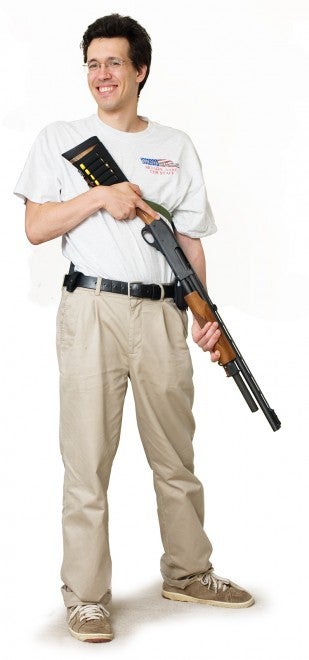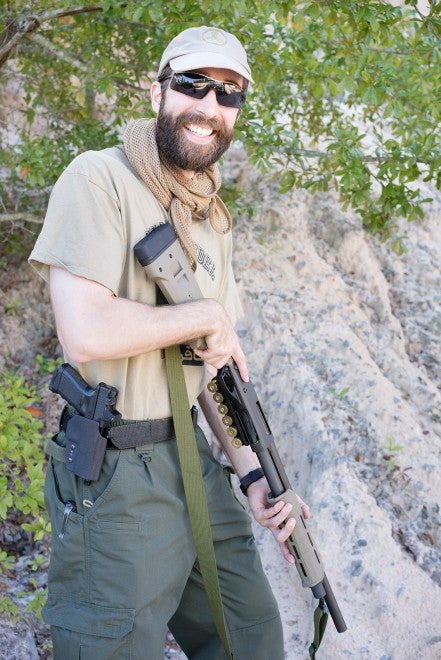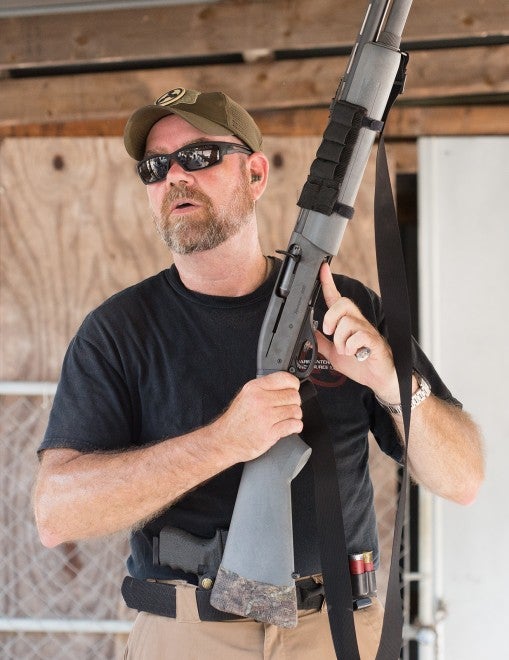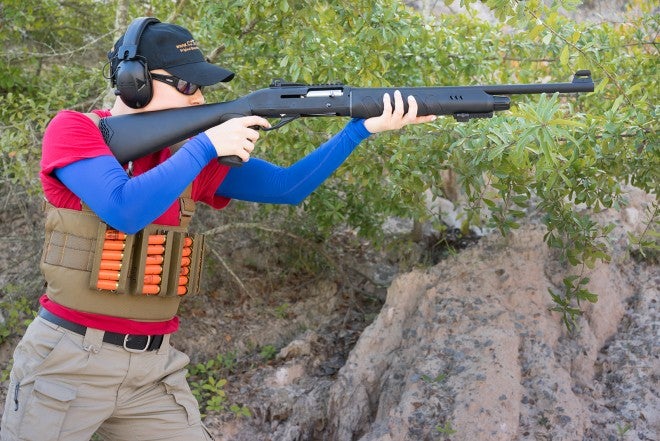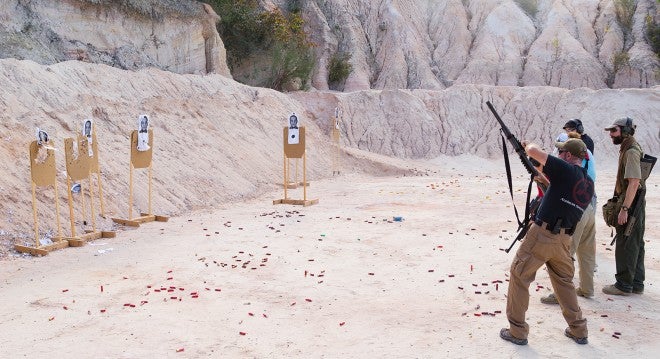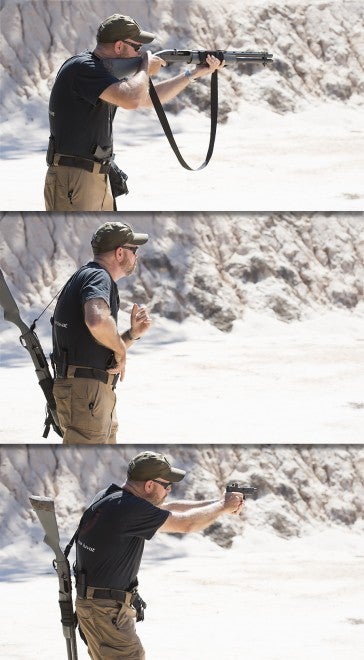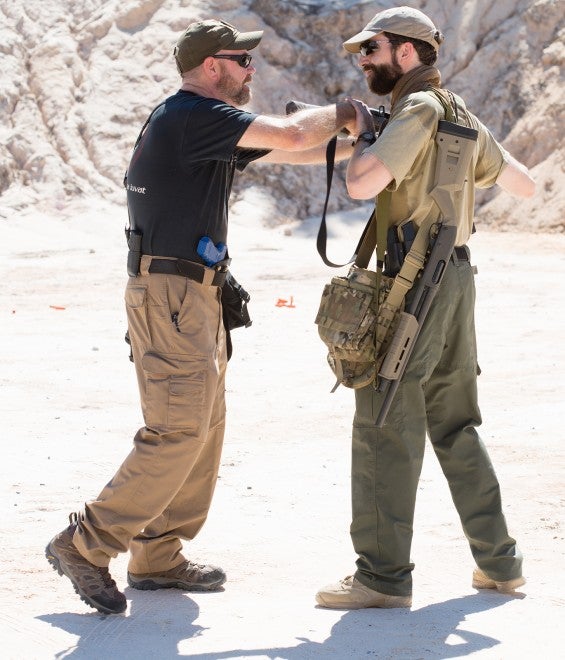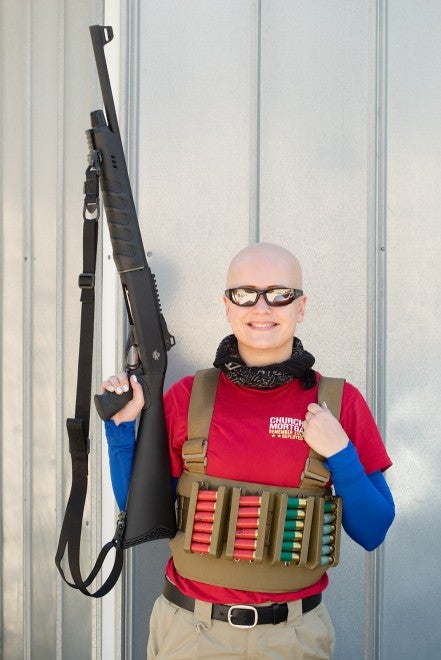Shotgun Training from Suarez International
Oleg Volk 01.18.16

Through the years, I’ve ended up with several shotguns in my safe, everything from a 20ga 1100 Youth to a box-fed 12ga Vepr. Being primarily a pistol and rifle shooter, I use them infrequently. My ability to wingshoot varies over time and from gun to gun, but I lack the familiarity with actually running scatterguns under stress. No sense in having weapons I can’t use effectively, right?
Back when Defensive Edge still offered shotgun courses, I went for a day and learned the basics, but that was back in 2001! So off to a refresher course I went. Since I already signed up to attend Suarez International pistol class in South Carolina, it made sense to take the shotgun course from the same people the following day. While people seem to either love or hate Gabe, the main draw to me were the two instructors, JD Lester and Alex Nieuwland, both gentlemen with a good reputation as trainers.
Alex handled primarily the pump action side of the technical explanations. As the class progressed, we found that pump gun shooters were generally able to reload their weapons with more certainty than the auto shooters. To offset that, were were slower between shots and more worn out by recoil by the day’s end.
JD Lester handled the autoloader questions. With several types of semiauto shotguns in class, it was a challenge to keep everyone straight on the details of the manual of arms, but he did a good job. One of the autoloaders was a pre-production sample of Armscor S605, too new even to have an instruction manual. Alex and JD helped the student–who has never fired a shotgun before in her life–figure out out in detail.
Out of the many available shotguns, I picked a humble Remington 1100 Youth 20ga with standard 4-shot tube. Despite its modest specifications, it proved a good choice, running reliably through the 300 or so shot day. Because of the light weight and mild recoil, further reduced by a Hi-Viz slip-on pad, I was tired but not in pain by sundown. The short stock extended by the pad worked better for me than an obnoxious muzzle brake would have. With the heat reaching 100*F and sunlight reflecting off the brilliant sand all around the range, heat endurance was a real problem for the shooters. Alex and JD did an excellent job of watching everybody’s vital signs and being ready with water or ice wraps as needed.
The student’s ammunition bearing vest represented one approach. I ran a 12-shot belt pouch for specialty ammunition and stuffed birdshot in every available pocket. The rest operated mainly from sidesaddles, stock pouches, and pockets. Keeping the shotguns topped-off was a challenge. Keeping them topped-off while staying aware of the environment was even harder. Much of the time, everyone was watching their guns more than the targets, despite the coaching designed to move all the weapon manipulation into the line of sight rather than lowering the eyes to the gun.
The course was conducted mainly at short range, with the emphasis on keeping the weapons functional and topped-off and showing how to transition from shotgun to pistol as necessary. Having got used to short slings on shotguns and generally handling them in a rifle-like fashion, I tried the loose sling approach and found it advantageous up close.
JD and Alex also demonstrated how a slung long gun can be used to control its owner in close quarters. Rather than tell the students how to operate, they usually showed several alternatives and then recommended practicing the approach that felt most logical. This non-dogmatic way of teaching appealed to me because I seldom take advice or instruction without questioning the details, and both instructors stood ready to explain the reasons behind the various solutions.
In general, I saw as many or more malfunctions with pumps attributable to short stroking than with autoloaders due to mechanical failures. Pleasantly, neither my 1100 nor Michelle DiCianni’s Armscor S65 had any failures at all. Since S65 was new, the instructors borrowed it the night before the class and were familiar with the manual of arms. In general, they were extremely attentive to each individual student and somehow able to pay attention to everything at once.
The course went over the safety basics and recommended weapon configurations first. The instructors explained why shotguns are worth knowing–the power and world-wide availability being the main benefits–and what their limitations are. A quick overview of shotgun munitions followed, with the emphasis on birdshot, buckshot, and slugs. Everyone’s guns got patterned at various ranges. JD and Alex did a good job of getting everyone’s questions answered while moving the narrative along and interspersing it with dry fire and live fire practice.
Much of the course was taken up by the practice of basic skills: working with a sling, sighting, or pointing, reloading and moving with the weapon ready. As various accessories on the students’ guns failed or required adjustment, the instructors were ready with parts and tools to get everyone back to the firing line.
Watching the training, I came away with several conclusions:
- Shotguns require a lot of tending even in a short fight, so trying several and picking the design that works for you is very important.
- Box magazines are much easier to use than tubes, at least for me. The issue is probably more the commonality of training with rifles than anything else, but attaching a magazine to either MKA1919 or a Vepr 12 is a gross motor skill, while loading individual shotshells takes finesse. That’s why AR-like controls are becoming more popular on fighting shotguns, Fostech Origin 12 being a good example.
- Recoils adds up quickly, so anything that mitigates it is welcome. Few shooters are as functional after a hundred rounds of 12ga buckshot through a pump as when they started, while autoloader shooters get worn down less.
- Situational awareness trumps weapon handling. It’s better to transition to a less powerful handgun than to stand in the open to feed an empty scattergun. Feeding a shotgun on the move can be done, but it requires a lot more training yet.
- The famous “transition to slug” drill is realistic with pumps but can be very complicated with certain semiautos. With those, it may be faster to fire off the remaining ammunition at the foe and them load a slug directly to the chamber.
- Recoil pads are good.
- Given the non-obvious nature of the manual of arms for many shotgun models, having competent instructors really helps in becoming better with them.
- Some better type of munition is needed to bridge the gap between short-range shot that lacks penetration and single-projectile slug requiring precise aiming. I started working on such a load and hope to have it in production later in 2016.
In sum, I very much recommend this course. It was well worth the long drive and dealing with the hot weather to learn. The event was attended by at least one couple, and their decision to stick to the same model shotgun for both was very much validated. With the limited ammunition capacity, shotgunners more than others benefit from a battle buddy to cover their reloads.
